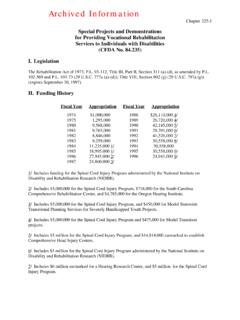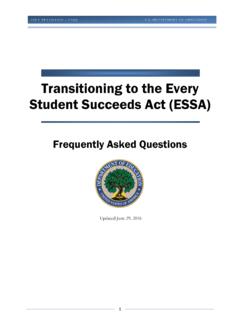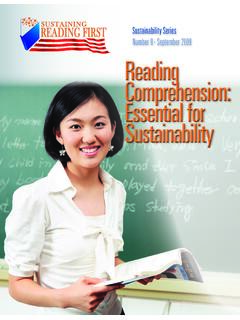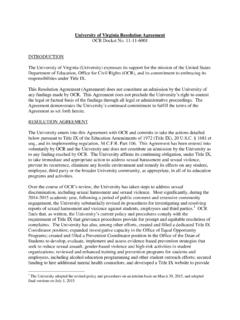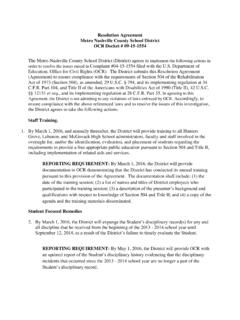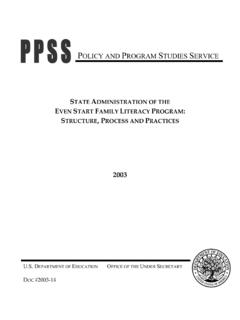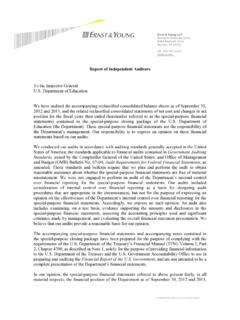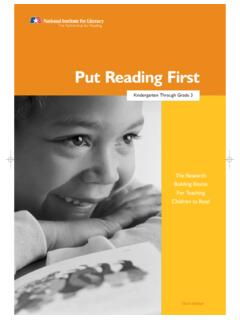Transcription of Chapter 1 Tools and Resources for Identifying All ... - ed
1 Updated November 2016 ESSA UPDATE INCLUDED*Updated November 2016 Chapter 1 Tools AND Resources FOR Identifying ALL ENGLISH LEARNERSThis is the first Chapter of the English Learner Tool Kit, which is intended to help state and local education agencies (SEAs and LEAs) meet their obligations to English Learners (ELs). This tool kit should be read in conjunction with the Department of Education Office for Civil Rights (OCR) and the Department of Justice s (DOJ) joint guidance, English Learner Students and Limited English Proficient Parents, published in January 2015, which outlines SEAs and LEAs legal obligations to EL students under civil rights laws and other federal requirements. The Dear Colleague Letter can be found at POTENTIAL ENGLISH LEARNERS1 Tools AND Resources FOR PROVIDING ELS WITH A language ASSISTANCE PROGRAM KEY POINTS LEAs must identify in a timely manner EL students in need of language assistance services.
2 The home language survey (HLS) is the most common tool used to identify potential ELs. An HLS must be administered effectively to ensure accurate must identify in a timely manner EL students in need of language assistance services. The home language survey (HLS) is a questionnaire given to parents or guardians that helps schools and LEAs identify which students are potential ELs and who will require assessment of their English language proficiency (ELP) to determine whether they are eligible for language assistance services. Many SEAs either require a state-developed HLS or provide a sample for LEAs to use; thus, it is advisable to check with the SEA about HLS has shown that there is a great deal of variation in HLS instruments across the United States (Bailey & Kelly, 2010). However, an HLS typically includes questions about what language (s) the student first learned, understands, uses, and hears, and in what contexts.
3 Additional questions about a student s language exposure and background ( , languages used in the home) help ensure that ELs are not missed, and guard against inaccurate reporting of the student s English abilities. Information from the HLS informs placement into a language assistance program ( , a bilingual and/or English as a Second language [ESL] program).To obtain accurate information, schools should reassure parents that the HLS is used solely to offer appropriate educational services, not for determining legal status or for immigration purposes. Parents and guardians should also be informed that, even if their child is identified as an EL, they may decline the EL program or particular EL services in the program.*This Chapter has been updated to reflect changes to the Elementary and Secondary Education Act (ESEA), as amended by the Every Student Succeeds Act of 2015 (ESSA).
4 The Department of Education has released a non-regulatory guidance (NRG) about ELs and Title III of the ESEA that is available at The text of ESEA, as amended by ESSA, can be found at can access Tools and Resources for Providing ELs with a language Assistance Program at November 20162 Tools AND Resources FOR PROVIDING ELS WITH A language ASSISTANCE PROGRAM ESSA UPDATEThe ESEA, as amended by ESSA, requires SEAs that receive Title III grants, after timely and meaningful consultation with local educational agencies, to create and implement standardized, statewide entrance and exit procedures for ELs, including an assurance that all students who may be [ELs] are assessed for such status within 30 days of enrollment in a school in the State. [ESEA section 3113(b)(2)]The following checklist is intended to assist with developing HLS instruments and procedures.
5 The checklist provides suggestions only, and schools and LEAs should check their SEA s policies to ensure compliance with state of the Home language Survey Is the purpose and use of the HLS clearly communicated to both families and those who administer the survey? Does the HLS elicit information about the student s current English abilities? Are the questions clear and understandable to those who administer the HLS?Translation of the Home language Survey Is the HLS translated into the home languages of students, and parents and guardians, in the school and LEA? Are qualified oral interpreters available when needed to help families complete the HLS?Procedures for Administering, Interpreting, and Managing results of the Home language Survey Has a welcoming environment been established where the HLS is disseminated, made available, or administered? Are there standard and uniform procedures for administering and interpreting the HLS results ?
6 Do the procedures describe whose responsibility it is to administer the HLS, how it is to be done, and in what forms it should be administered ( , orally, written, in English, or in a home language translation)? Are there procedures to document and describe how to train the staff who will administer the HLS and how often refresher training will occur? Do procedures provide specific guidelines for interpreting HLS responses that include but are not limited to the following considerations: (a) Which responses indicate that a student will take an ELP placement test?; (b) How should responses be interpreted as a whole?; and (c) What are the next steps if responses are unclear or contradictory? Do procedures include methods to record HLS results in the student s permanent records and to record the translation and interpretation needs of the EL s parents in the student information system?
7 What is the continuous review process? Is there a process to gather feedback from parents and school personnel? Is there a process to revise the HLS, including piloting a new version as appropriate?Reference: Linquanti, R.,& Bailey, (2014). Reprising the home language survey: summary of a national working session on policies, practices, and Tools for Identifying potential English Learners. Washington, DC: Council of Chief State School Officers. Retrieved from can access Tools and Resources for Providing ELs with a language Assistance Program at November 20163 Tools AND Resources FOR PROVIDING ELS WITH A language ASSISTANCE PROGRAM DETERMINING WHICH STUDENTS ARE ENGLISH LEARNERSKEY POINTS All potential ELs must be assessed with a valid and reliable assessment to determine if they are in fact ELs. Parents and guardians must be informed in a timely manner of their child s ELP level and EL program options.
8 LEAs are required to communicate information regarding a child s ELP level and EL program options in a language the parent students are identified as potential ELs, they must be assessed with a valid and reliable assessment to determine if they are indeed ELs. LEAs and SEAs commonly refer to these assessments as placement/screener tests. Placement/screener tests are typically selected at the SEA level. Such ELP tests must assess the proficiency of students in all four language domains ( , speaking, listening, reading, and writing). Some SEAs and LEAs also use ELP assessments that evaluate speaking, listening, pre-reading, and pre-writing for entering kindergarten students with a primary or home language other than tests require that those administering and scoring them receive some level of training. LEA guidelines should describe who will administer and score assessments, and what training is required to ensure valid and reliable results .
9 After the student completes the assessment, parents or guardians must receive in a timely manner information about the student s ELP level and program options, and an opportunity to opt out of the EL program or particular EL services in the program. Translating this information into the family s home language is critical, and if a written translation is not provided, an oral interpretation should be made available whenever can access Tools and Resources for Providing ELs with a language Assistance Program at can access Tools and Resources for Providing ELs with a language Assistance Program at ALL ENGLISH LEARNERSTOOLSThe Department of Education does not mandate or prescribe particular curricula, lesson plans, assessments, or other instruments in this tool kit. Rather, this tool kit contains examples, adaptations of, and links to Resources created and maintained by other public and private organizations.
10 This information is provided for the reader s convenience and is included here as an example of the many Resources that educators, parents, advocates, administrators, and other concerned parties may find helpful and use at their discretion. The Department of Education does not control or guarantee the accuracy, relevance, timeliness, or completeness of this outside information. Further, the inclusion of links to Resources does not reflect their importance, nor is such inclusion intended to endorse any views expressed or materials language SURVEYSThe following information about home language surveys is provided for the reader s convenience and is included here to offer examples. LEAs are reminded to check with their SEAs to see if a particular HLS is prescribed, and, if so, what the current version following three HLS questions have been approved by the Department of Education Office for Civil Rights (OCR) and the Department of Justice (DOJ) in their compliance work under Title VI of the 1964 Civil Rights Act and the Equal Educational Opportunities Act of 1974.

